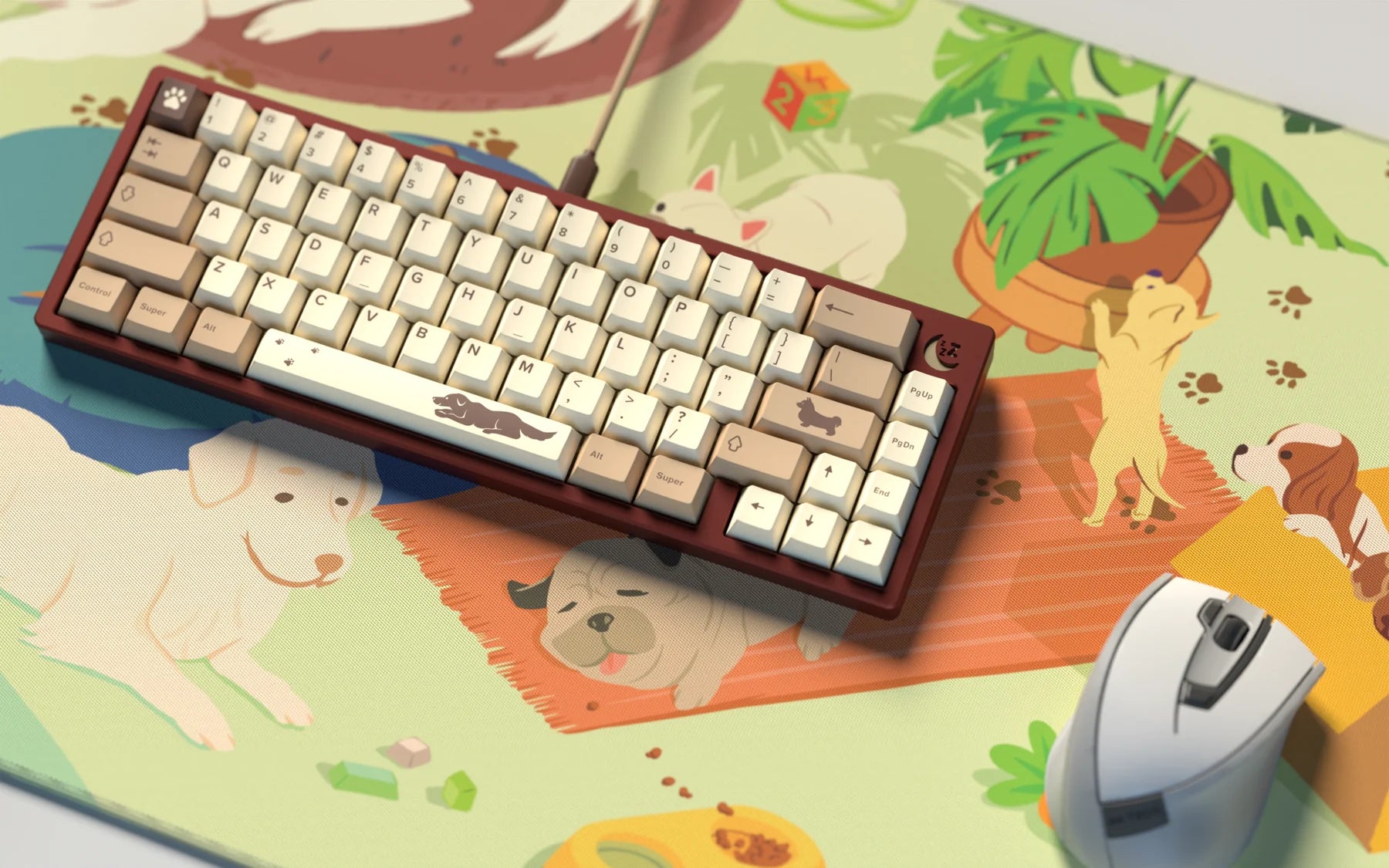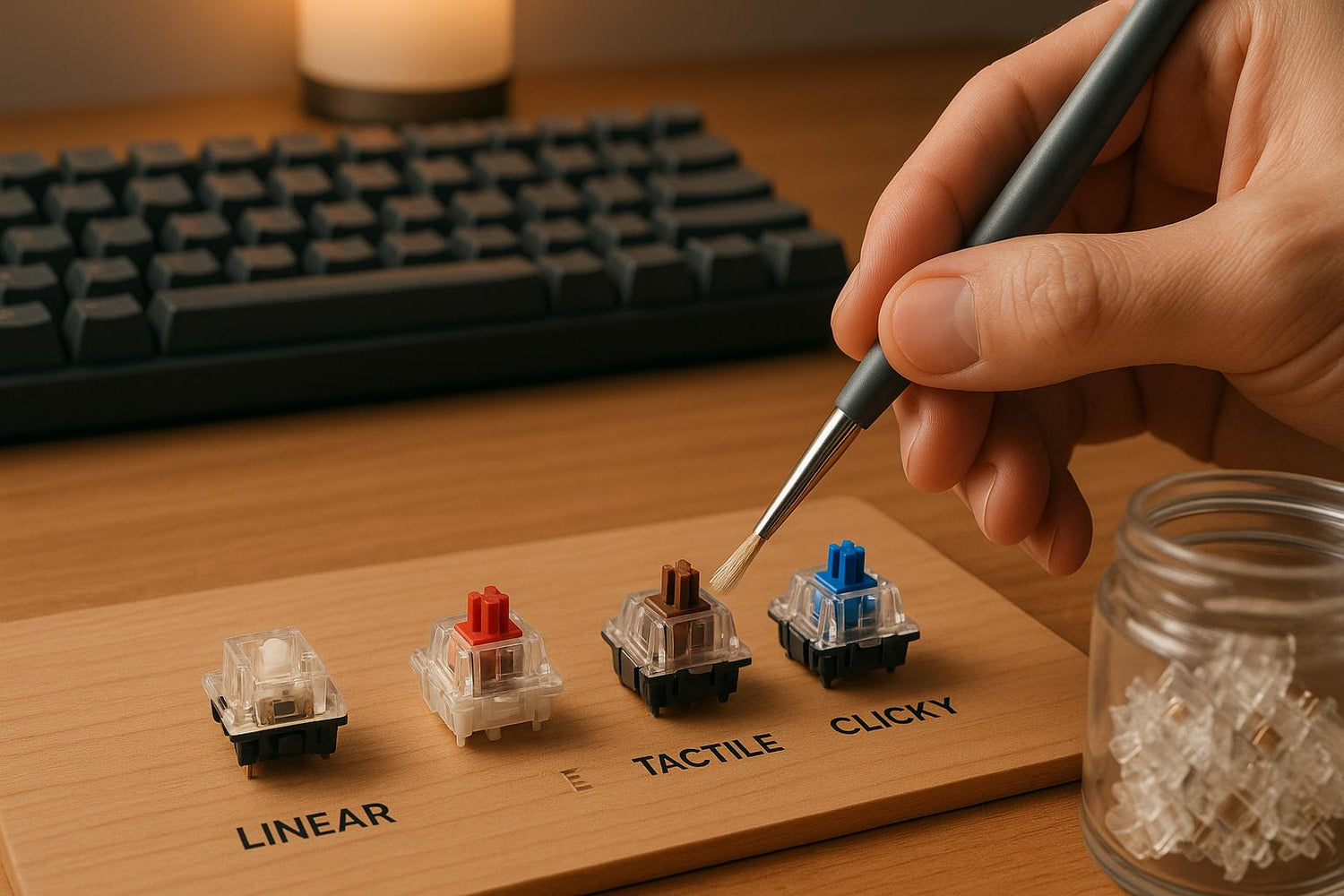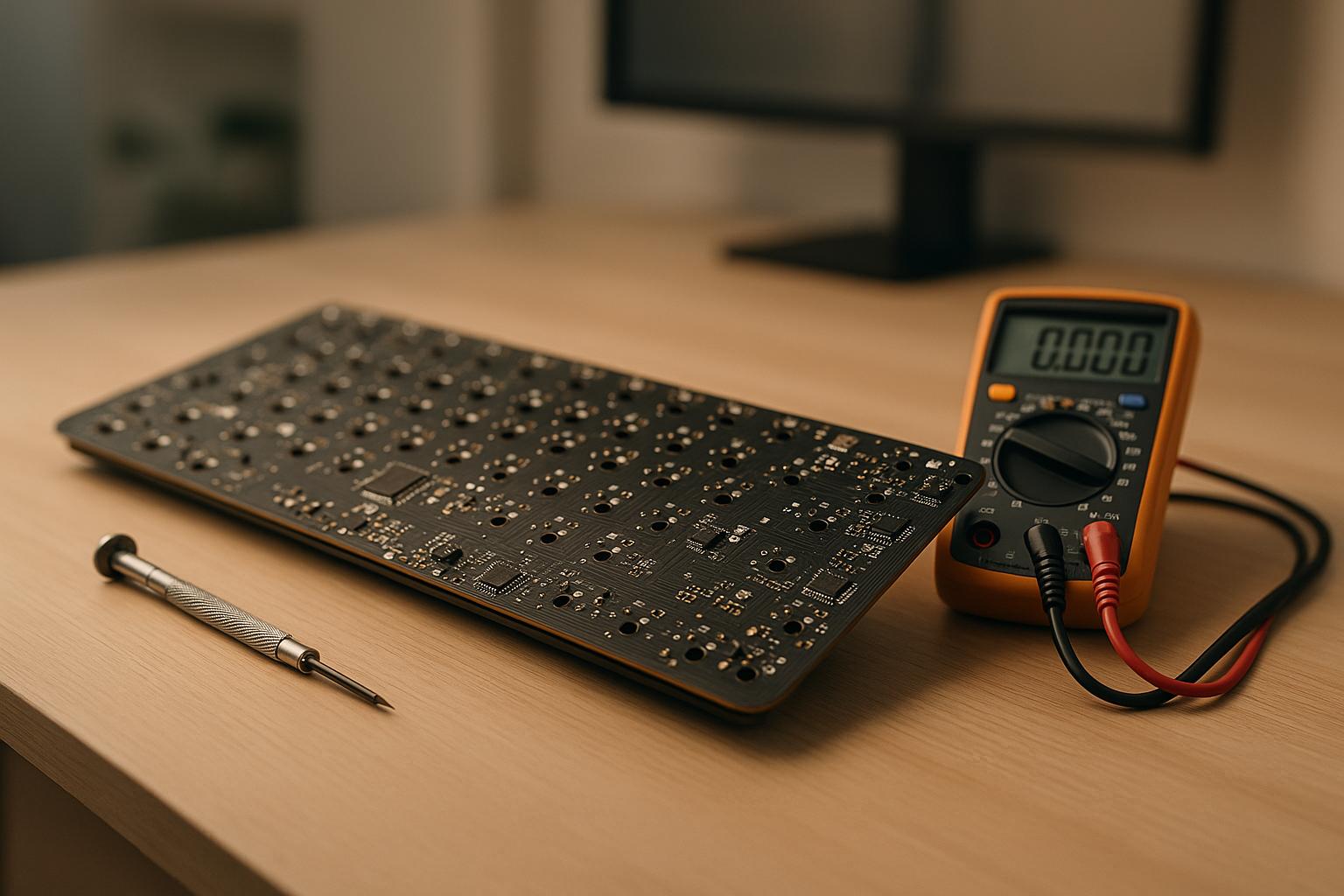Switch modding improves how your keyboard feels, sounds, and performs by reducing friction in the switches. Lubricating switches smooths out keystrokes, reduces noise, and ensures consistent performance across all keys. Here's a quick overview of what you need to know:
- Linear switches: Smooth, quiet, and great for gaming. Use thicker lubes like Krytox 205g0 for a buttery feel.
- Tactile switches: Provide a noticeable bump for typing feedback. Use lighter lubes like Tribosys 3203 to maintain that tactile feel.
- Clicky switches: Produce a click sound and tactile bump. Apply minimal lube to avoid altering the click.
Key tools and materials:
- Switch opener, fine brushes, tweezers, and lubricants like Krytox or Tribosys.
- Optional items: lube station, small trays, or containers for organization.
Tips for success:
- Use less lube than you think is needed.
- Avoid lubing tactile legs or click mechanisms to preserve switch feedback.
- Test each switch after lubing to ensure proper feel and sound.
Regular maintenance, like cleaning and re-lubing every 6–12 months, keeps your switches performing well. For supplies, check out stores like KeebsForAll for tools and lubricants. Ready to mod? Let’s dive in.
Lube Every Type of Mechanical Keyboard Switch! Tactile, Linear, Silent, Box!
Tools and Materials for Switch Lubing
Having the right tools and materials is key to making your switch lubing process smooth and efficient. Here's a breakdown of the essentials.
Required Tools and Supplies
A switch opener is a must-have for safely opening switches without risking damage to the housing.
When it comes to lubricants, your choice depends on the type of feel you're aiming for:
- Krytox GPL 205g0: Perfect for a buttery-smooth feel in linear switches.
- Tribosys 3204: Offers a balanced feel, ideal if you want a mix of smoothness and feedback.
- Tribosys 3203: Best for preserving tactile feedback in switches.
You'll also need a few additional tools:
- Fine synthetic brushes for precise and even application of lubricant.
- Tweezers for handling tiny switch components.
- Keycap and switch pullers to safely remove keycaps and switches.
While optional, a lube station can be handy for keeping switch parts organized during the process. If you don’t have one, small trays or containers work just as well.
Lastly, consider the type of lubricant you use. Grease-based lubricants like Krytox 205g0 last longer but can alter the switch feel, while oil-based lubricants require reapplication but maintain the original characteristics of the switch.
Getting Materials from KeebsForAll

If you’re looking for a one-stop shop, KeebsForAll has you covered with all the tools and lubricants you need for switch modding.
- KeebsForAll Switch Opener: Durable and precise, priced at $19.00, it ensures safe and efficient switch separation.
-
Lubricants:
- Krytox 205g0 Switch Lubricant starts at $7.95 (down from $9.95).
- Tribosys 3204 and Tribosys 3203 are both available starting at $8.00, with Tribosys 3203 being a great choice for tactile switches.
- Krytox GPL 105 Oil ($10.00) and Krytox GPL 106 Oil Spring Lubricant ($11.00, discounted from $14.00) are excellent for springs and minimal impact on switch characteristics.
Other helpful tools include Lube Brushes ($4.00) and Stem Holders ($4.90), perfect for keeping everything organized while you work. Plus, KeebsForAll sweetens the deal with free shipping on orders over $70 within the USA, making it a great option for stocking up on supplies for bigger projects.
How to Lube Switches Step by Step
Ready to dive into lubing your switches? Each type of switch has its own quirks, so it’s important to approach them differently to retain their unique feel while enhancing their performance.
Before you begin, here’s a key piece of advice from the pros: use less lube than you think you need. As Taeha Types says, "Less is more". If needed, document your process to keep track of what works best.
Now, let’s break it down step by step for each switch type.
Lubing Linear Switches
Linear switches are the easiest to lube because you don’t have to worry about preserving tactile feedback or a clicking sound. A popular choice for this task is Krytox 205 g0, which helps create that smooth, buttery feel.
- Start with the bottom housing. Open the switch and apply a thin layer of lubricant to the interior sliders where the stem moves. Use a fine synthetic brush to spread it evenly for smooth stem travel.
- Move to the stem. For linear switches, you can freely lube the stem legs. Apply a light coat to the sides of the legs and the space between them to eliminate any scratchiness during key presses.
- Don’t forget the spring. Remove it from the switch and apply a thin coat of lubricant along its length. This reduces unwanted spring noise.
- Finish with the upper housing. Apply a small amount of lubricant to the interior surfaces where the stem makes contact during movement.
When reassembling, handle the crosspoint contacts carefully to avoid bending them. Test the switch by pressing it a few times before moving on to the next one.
Lubing Tactile Switches
Tactile switches require a more delicate touch to maintain their signature bump while improving smoothness. Tribosys 3203 works well for this type of switch.
- Begin with the bottom housing. Apply a light coat of Tribosys 3203 to the interior sliders, but avoid the metal leaf spring area. Lubricating the leaf can dull the tactile feedback.
- Handle the stem carefully. Unlike linear switches, you should not lube the tactile legs. These legs create the bump, and adding lubricant can make the switch feel mushy. Focus on the flat surfaces of the stem instead, or skip lubing the sides altogether.
- Lube the spring. Just as with linear switches, apply a thin layer of lubricant to the spring to minimize noise.
- Finish with the upper housing. Use a very small amount of lubricant to avoid interfering with the tactile response.
If your tactile switches lose their bump after lubing, you may have accidentally lubed the tactile legs. Wipe off the lubricant from the stem’s legs and rails to restore the tactile feel.
Lubing Clicky Switches
Clicky switches are trickier to mod because their click mechanism is what gives them their distinct sound. If you’re determined to lube them, proceed with caution.
- Avoid the click mechanism. The click jacket and click bar are responsible for the click sound. Lubricating these parts can muffle or completely eliminate the click.
- Focus on the spring. Remove the spring and apply a very light coat of lubricant to reduce spring noise without affecting the click mechanism.
- Be extremely selective with other components. If you decide to lube other parts, stick to the friction points where the stem contacts the housing. Use the smallest amount possible and avoid any click-related components.
Reassembling clicky switches can be tricky due to their more complex mechanisms. Take your time to ensure everything is aligned properly before snapping the housing back together. Test each switch as you go to catch any issues early.
sbb-itb-3cb9615
Linear vs Tactile vs Clicky Switch Lubing
When it comes to lubing switches, each type - linear, tactile, and clicky - has its own quirks and requirements. How you apply lubricant can significantly impact the feel and sound of your switches, so understanding these differences is crucial.
Linear switches are the most forgiving when it comes to lubrication. Since they lack a tactile bump, you can use thicker lubricants like Krytox 205g0 to achieve a buttery-smooth keystroke. Tactile switches, on the other hand, require a more delicate touch. Their bump provides essential feedback, so you’ll need a thinner lubricant like Tribosys 3203 and careful application to avoid dulling the tactile sensation. For clicky switches, minimal lubrication is the name of the game. Over-lubing can compromise the click mechanism, so focus on targeted application and stick to very light coatings when needed.
The margin for error also varies by switch type. Linear switches can handle a bit of excess lube without major issues, while tactile switches demand precision to preserve their feedback. Clicky switches leave almost no room for mistakes - overdoing it can permanently alter their signature click.
Switch Type Comparison Table
| Aspect | Linear Switches | Tactile Switches | Clicky Switches |
|---|---|---|---|
| Recommended Lube | Krytox 205g0 (thicker) | Tribosys 3203 (thinner) | Minimal lubing recommended |
| Stem Legs | Lube freely | Avoid completely | Avoid completely |
| Bottom Housing | Full coverage | Avoid metal leaf | Minimal contact points only |
| Spring | Light coating | Light coating | Very light coating |
| Click Mechanism | N/A | N/A | Never lube |
| Difficulty Level | Beginner-friendly | Intermediate | Advanced |
| Expected Sound Change | Deeper, quieter | Slightly muted | Risk of losing click |
| Expected Feel Change | Much smoother | Smoother with preserved bump | Minimal change desired |
| Common Mistakes | Over-lubing springs | Lubing tactile legs | Lubing click components |
| Recovery from Mistakes | Easy cleanup | Moderate cleanup required | Often permanent damage |
After lubing, thorough testing is a must. For linear switches, ensure the keystroke feels smooth from start to finish. Tactile switches should still provide a clear, satisfying bump, and for clicky switches, confirm that both the tactile feedback and the audible click remain intact.
Fixing Problems and Maintaining Switches
Even experienced enthusiasts face issues after lubricating switches. Identifying and addressing these problems can save you both time and frustration.
Common Lubing Problems and How to Address Them
Mushy or sluggish keys are one of the most common complaints after lubing. This happens when too much lubricant is applied, making the switch feel unresponsive. To fix this, remove the affected switches and gently wipe off the excess lubricant using a clean cloth or cotton swab. Pay close attention to areas like the spring and contact points, as these often collect excess lube.
Loss of tactility in tactile switches can ruin the typing experience. If your tactile switches feel more like linear ones after lubing, it’s likely that lubricant has gotten onto the stem legs or tactile rails. Disassemble the switch and carefully clean off the lubricant from these areas to restore the intended tactile feedback.
Non-responsive keys usually indicate a more serious issue. Start by checking the switch pins, as they might have bent during installation. If the pins are bent, use tweezers or needle-nose pliers to straighten them. If the pins are intact, inspect the PCB for damage and, if necessary, replace the faulty switch.
Inconsistent smoothness across the keyboard often means some switches weren’t lubricated evenly or that certain contact points were missed. To resolve this, remove the uneven switches and reapply lubricant where needed. Applying lube sparingly from the start helps avoid this problem, as removing excess lubricant can be a tedious process.
Routine maintenance can help prevent these issues from cropping up again.
Switch Care and Re-Lubing
Lubed switches require periodic upkeep to stay in top shape. Cleaning every 3 to 6 months helps remove dust and debris that can interfere with switch performance. Use compressed air for clearing out debris and a microfiber cloth dampened with isopropyl alcohol to clean the keyboard’s surface.
Signs your switches need re-lubing include inconsistent key presses, squeaking or rattling sounds, key chatter (registering multiple inputs from a single press), or increased resistance that makes keys feel sluggish. For most users, re-lubing every 6 to 12 months is sufficient, though heavy typists or those in dusty environments may need to do it more frequently.
Before re-lubing, take the time for a deep cleaning. Remove the keycaps and soak them in warm water with dish soap, scrubbing gently with a soft brush. Let them dry completely before reattaching. For the switches, use cotton swabs dipped in isopropyl alcohol (70% or higher) to clean the internal parts. Ensure all alcohol has evaporated before reassembling the switches.
If you’re unsure whether your switches need lubing, they probably don’t. Trust your typing experience - when the keys start feeling different or less responsive, it’s time to take action.
When applying fresh lubricant, make sure to remove any old residue first. Starting with a clean surface ensures smooth and consistent performance.
Conclusion
Lubing your keyboard switches can completely change the way your keyboard feels and sounds. By reducing friction between moving parts, lubrication creates smoother keystrokes and eliminates that unpleasant scratchy sensation. Plus, it enhances the sound profile - lubed switches produce a deeper, more satisfying sound by cutting down on friction noise. This is especially noticeable with linear and tactile switches, while clicky switches require a much lighter touch to preserve their signature click.
Beyond the immediate feel and sound improvements, lubing also helps extend the lifespan of your switches. By minimizing wear and tear on internal components, your keyboard can continue to perform consistently, even if you're typing or gaming daily.
Key Points to Keep in Mind
The benefits of switch lubrication are undeniable, but achieving great results requires the right approach. Using high-quality, keyboard-specific lubricants like Krytox GPL-205 or Tribosys 3204 ensures smooth performance. On the flip side, using the wrong lubricant can make switches feel sticky or even cause damage.
When it comes to applying lubricant, precision beats quantity every time. A thin, even layer on the correct contact points is all you need for smooth performance. Overdoing it can dampen the sound and make switches feel mushy - almost like a membrane keyboard. Take your time to test each switch for how it feels and sounds, and adjust your technique as necessary.
Different switch types call for different lubing techniques. Linear switches benefit from thorough lubrication on all contact points. Tactile switches require a more careful approach to avoid dulling their tactile bump. For clicky switches, less is more - apply sparingly to maintain their distinct clicking sound.
Regular maintenance is also key. Pay attention to any changes in your keyboard’s sound or feel, and don’t hesitate to clean and re-lube when needed. With proper care, your lubed switches can provide years of smooth, enjoyable typing and gaming.
For the best tools and materials, check out KeebsForAll. They offer everything from precision tools to replacement switches and stabilizers, so whether you’re modding your first keyboard or maintaining a collection, you’ll have access to professional-grade supplies for consistently satisfying results.
FAQs
What are the advantages of lubing keyboard switches, and how does it impact performance and durability?
Lubing keyboard switches comes with a range of perks. First off, it cuts down on friction between the moving parts inside the switches. This means smoother, quieter, and more consistent keystrokes - something that can make a world of difference for both typing and gaming enthusiasts who prioritize comfort and precision.
On top of that, lubing helps reduce wear and tear, which can extend the life of your switches. With proper care, switches are capable of enduring tens of millions of keystrokes, keeping your keyboard dependable for years to come. To keep things running smoothly, it's a good idea to re-lube your switches every 6 to 12 months, depending on how heavily you use your keyboard.
What are the best practices for lubing tactile and clicky switches without compromising their unique feel and sound?
When lubing tactile and clicky switches, precision is key to maintaining their distinct feedback and sound. Apply a thin layer of lubricant and steer clear of the stem legs and metal leaf. Lubing these areas can reduce tactility or interfere with the click mechanism. Instead, lightly coat the sides of the stem and the spring to improve smoothness without compromising the switch's signature feel.
Using too much lubricant can leave switches feeling sluggish or uneven. Start with a small amount, test the results, and adjust as needed. By applying lubricant sparingly and evenly, you can enhance the switch’s performance while preserving its unique characteristics. Take your time - when it comes to lubing tactile and clicky switches, a "less is more" approach works best.
How can I tell when my keyboard switches need re-lubing, and how often should I do it?
If your keyboard switches start to feel inconsistent or stiff, make squeaking or rattling noises, or seem sluggish and unresponsive, it might be time to re-lube them. Other telltale signs include keys registering multiple inputs or feeling unusually resistant while typing.
Generally, it's a good idea to re-lube your switches every 6 to 12 months, though this depends on how often you use your keyboard. For those who type heavily every day, more frequent maintenance might be necessary to keep everything running smoothly.



![[Pre-Order] Autumn Leaves PBT Keycaps - KeebsForAll](http://keebsforall.com/cdn/shop/products/DSC09732.jpg?v=1676148273)






Leave a comment
This site is protected by hCaptcha and the hCaptcha Privacy Policy and Terms of Service apply.